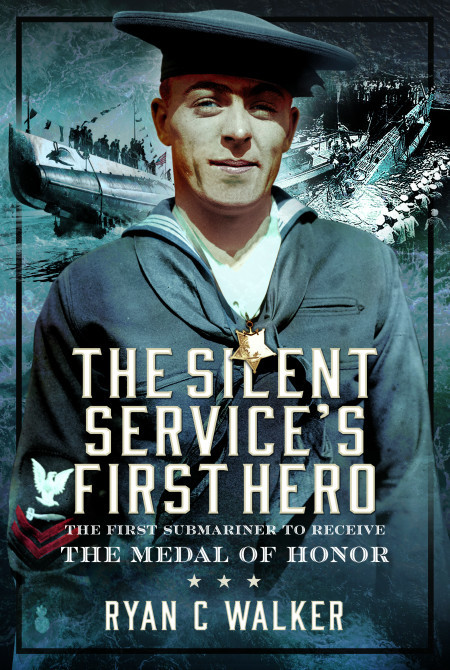Author Guest Post: Ryan C Walker
Not Another Military Biography
By Ryan C Walker
The United States Submarine Force has eight Medal of Honor Recipients who received their award while serving aboard a submarine.[1] Only one was an enlisted submariner, and he happened to be the first as well.
On October 28, 1923, nearly 100 hundred years ago, the USS O-5 was beginning to transit the Panama Canal when it collided with the United Fruit Company’s Abangarez and sank within a minute. Most of the crew managed to get overboard, but one sailor made a fateful decision that ended up saving the life of his shipmate. His Medal of Honor Citation reads:
For heroism and devotion to duty while serving on board the U.S. submarine 0-5 at the time of the sinking of that vessel. On the morning of 28 October 1923, the 0-5 collided with the steamship Abangarez and sank in less than a minute. When the collision occurred, Breault was in the torpedo room. Upon reaching the hatch, he saw that the boat was rapidly sinking. Instead of jumping overboard to save his own life, he returned to the torpedo room to the rescue of a shipmate who he knew was trapped in the boat, closing the torpedo room hatch on himself. Breault and Brown remained trapped in this compartment until rescued by the salvage party 31 hours later.[2]
I first learnt of this story while as a twenty-year old aspiring submariner who had just graduated Recruit Training Command. As part of an assignment, I visited the Submarine Force Library and Museum in Groton, CT and found Breault’s exhibit in the Medal of Honor section.

Ryan C Walker, (photographer,) Submarine Force Library & Museum, Henry Breault: Torpedoman 2nd Class, U.S. Navy, U.S.S. O-5, Museum Exhibit, Medal of Honor Section
The exhibit struck me profoundly. It shaped my perceptions of what was expected of me as I qualified in submarines. A submariner needed to be able to risk his life to save his shipmate’s in the most stressful of circumstances.
I had wanted to learn more about Breault, so when I attended the University of Portsmouth’s Naval History MA course and discovered there was a smaller research project, I determined that I would take the opportunity to discover more about Breault. As I’ve stated before in my article on Breault, I was shocked at how little we knew about Breault as a person, as most records came from two articles by Julius Grigore Jr. and several collections organized by local and submarine museums.[3] Breault remained a largely unknown figure known for his inspirational action that led to his award.

Unknown Photographer, Henry Breault, March 8, 1924, Library of Congress Photograph, https://www.loc.gov/item/2016836979/.
That is until this book. In The Silent Service’s First Hero, I explore Breault’s life and the context of his life as a sailor in the Royal Navy Canadian Volunteer Reserve during World War I and as a submariner in the United States Navy from 1920-41. This work seeks to be a microhistory, an inversion of total history that centres on one man’s life and his connection to the world. Utilizing recently digitized information in Breault’s Official Military Personnel File, newspapers, census records, and archival documents, I have reconstructed Breault’s life so that history can be seen as it was seen and understood through the eyes of a submariner.
The Silent Service’s First Hero is not just another military biography following a high-ranking officer through war. This is a book that seeks to explore the submariner archetype. It offers a new way to understand the context of how an enlisted sailor could experience 1920’s and 1930’s America by exploring the challenges of marriage, low pay, alienation, transfers, in an era where military personnel were often overlooked. Henry Breault’s life is a gold mine for historians seeking to understand the period he lived in, as a sailor he was both a part and apart from American culture, and I hope this work inspires a renewed search for artifacts and documentation.
[1]. Both Paul F. Foster (1914) and William R. Charette (1953) received their Medals of Honor in battle and later in their careers became submariners.
[2]. Congressional Medal of Honor, “Henry Breault,” accessed July 2, 2023, https://www.cmohs.org/recipients/henrybreaultgclid=Cj0KCQjwwISlBhD6ARIsAESAmp72wFwPEkx9RiCGLmK_s9yRCjV_6PyJ-yegzIx5BhsIFTCcD2vds94aAsGeEALw_wcB
[3]. Ryan C. Walker, “Henry Breault: Construction of a Naval Hero,” International Journal of Maritime History, 35, no. 1 (December 2022): 46-70, https://doi.org/10.1177/08438714221145491.

The Silent Service’s First Hero will be published in 2024.

